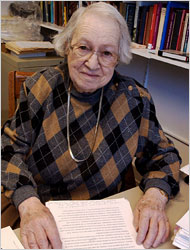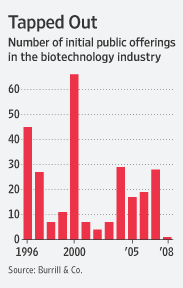
“Marjorie Grene in 2003.” Source of photo and caption: online version of the NYT obituary quoted and cited below.
The NYT reported, in the obituary quoted below, that philosopher Marjorie Grene died on March 16, 2009, at the age of 93.
Although I studied philosophy at the University of Chicago, my time there did not overlap with Marjorie Grene’s and I don’t believe that I ever met her, or ever even heard her speak (though I did occasionally walk past her former husband David Grene, on my way to talk to Stephen Toulmin).
I am increasingly appreciating Michael Polanyi’s book Personal Knowledge in which he introduced his view of what he called “tacit knowledge.” In particular, I am coming to believe that tacit knowledge is very important in understanding the role and importance of the entrepreneur.
So if Marjorie Grene was crucial to Personal Knowledge, as is indicated in the obituary quoted below, then she is deserving of serious consideration, and high regard.
(p. 23) In Chicago, she had met Michael Polanyi, a distinguished physical chemist turned philosopher; she ended up helping him research and develop his important book “Personal Knowledge” (1958). The book proposed a far more nuanced, personal idea of knowledge, and directly addressed approaches to science.
“There is hardly a page that has not benefited from her criticism,” Dr. Polanyi wrote in his acknowledgments. “She has a share in anything I may have achieved here.”
. . .
Her sense of humor sparkled when she was asked about being the first woman to have an edition of the Library of Living Philosophers devoted to her — Volume 29 in 2002. Previous honorees included Bertrand Russell and Einstein. “I thought they must be looking desperately for a woman,” Dr. Grene said.
For the full obituary, see:
DOUGLAS MARTIN. “Marjorie Grene, a Leading Philosopher of Biology, Is Dead at 98.” The New York Times, First Section (Sun., March 29, 2009): 23.
(Note: ellipsis added.)
The reference for the Polanyi book, is:
Polanyi, Michael. Personal Knowledge: Towards a Post-Critical Philosophy. Chicago: University Of Chicago Press, 1958.





